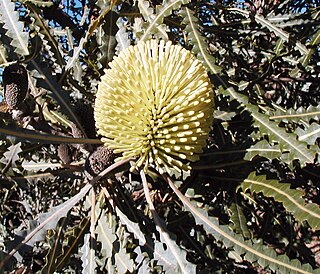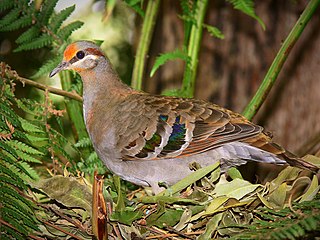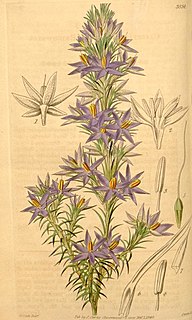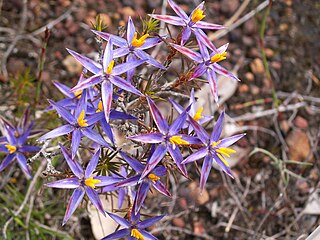
Banksia elegans, commonly known as the elegant banksia, is a species of woody shrub that is endemic to a relatively small area of Western Australia. Reaching 4 m (13 ft) high, it is a suckering shrub that rarely reproduces by seed. The round to oval yellow flower spikes appear in spring and summer. Swiss botanist Carl Meissner described Banksia elegans in 1856. It is most closely related to the three species in the subgenus Isostylis.
The ecology of Banksia refers to all the relationships and interactions among the plant genus Banksia and its environment. Banksia has a number of adaptations that have so far enabled the genus to survive despite dry, nutrient-poor soil, low rates of seed set, high rates of seed predation and low rates of seedling survival. These adaptations include proteoid roots and lignotubers; specialised floral structures that attract nectariferous animals and ensure effective pollen transfer; and the release of seed in response to bushfire.

Triodia is a large genus of hummock-forming bunchgrass endemic to Australia. They are known by the common name spinifex, although they are not a part of the coastal genus Spinifex. Many of the soft-leaved members of this species were formerly included in the genus Plectrachne.

The brush bronzewing is a species of bird in the pigeon family, Columbidae. It is endemic to Australia, with two biogeographically distinct subspecies.

Calectasia is a genus of flowering plants in the family Dasypogonaceae. They are commonly referred to as tinsel lilies, and are endemic to southern Australia.

Dipodium, commonly known as hyacinth orchids, is a genus of about forty species of orchids native to tropical, subtropical and temperate regions of south-east Asia, New Guinea, the Pacific Islands and Australia. It includes both terrestrial and climbing species, some with leaves and some leafless, but all with large, often colourful flowers on tall flowering stems. It is the only genus of its alliance, Dipodium.

Calectasia intermedia, commonly known as blue tinsel-lily or eastern tinsel lily is a species of flowering plant in the family Dasypogonaceae, endemic to the border areas of western Victoria and south-eastern South Australia and flowering in early spring. It is the only member of the genus Calectasia that is not endemic to Western Australia.
Alessandro "Sandro" Pignatti is an Italian botanist specialising in pteridophytes and spermatophytes. The Australian plant species Calectasia pignattiana was named after him. On 31 May 1991 Pignatti received an honorary doctorate from the Faculty of Mathematics and Science at Uppsala University, Sweden. He is a Honorary Member of the International Association for Vegetation Science (1997).
C. elegans most commonly refers to the model round worm Caenorhabditis elegans. It may also refer to any of the species below. They are listed, first in taxonomic order and, second, alphabetically.

Calectasia grandiflora, commonly known as the blue tinsel lily, is a plant in the family Dasypogonaceae growing as a perennial herb endemic to the south-west of Western Australia. It flowers in spring.

Calectasia cyanea, commonly known as the star of Bethlehem or blue tinsel lily, is a plant in the family Dasypogonaceae growing as a perennial herb and is endemic to the south–west of Western Australia. Restricted to a single population in Torndirrup National Park, it is critically endangered.
Calectasia browneana, commonly known as blue tinsel lily, is a plant in the family Dasypogonaceae growing as a spreading, perennial, tufted herb. It is an uncommon species, endemic and restricted to a few areas in the south-west of Western Australia. It is similar to the other species of Calectasia and has only been recognised as a separate species since a review of the genus in 2001. It is distinguished from the others mainly by the hairiness of its leaves and lack of a rhizome.

Calectasia gracilis, commonly known as blue tinsel lily, is a plant in the family Dasypogonaceae and is endemic to the south-west of Western Australia. It is a spreading, tufted, woody, perennial herb with blue petals and six yellow stamens that turn orange-red as they age. It is similar to the other species of Calectasia and has only been recognised as a separate species since a review of the genus in 2001.

Calectasia hispida, commonly known as blue tinsel lily or hispid tinsel lily, is a plant in the family Dasypogonaceae growing as a rhizomatous, erect, clumping perennial herb. It is endemic to the south-west of Western Australia and is common in most of its range. It is similar to the other species of Calectasia and is distinguished from them mainly by the hairiness of its leaves and the glabrousness of the throat of the flowers.
Calectasia keigheryi, commonly known as blue tinsel lily, is a plant in the family Dasypogonaceae growing as an erect, rhizomatous, perennial herb. It is an uncommon species, endemic and restricted to a few areas in the south-west of Western Australia. It is similar to the other species of Calectasia and has only been recognised as a separate species since a review of the genus in 2001. It is relatively easily distinguished from the others mainly by its smaller flowers, unusual anther shape, and hairs on the lower part of the petals.

Calectasia narragara, commonly known as a blue tinsel lily or star of Bethlehem, is a plant in the family Dasypogonaceae growing as a tufted rhizomatous herb. It is endemic to the south-west of Western Australia and common in most of its range.
Calectasia pignattiana, commonly known as the stilted tinsel lily or Pignatti's star of Bethlehem, is a plant in the family Dasypogonaceae growing as a perennial herb and is endemic to the south–west of Western Australia. It is only known from ten locations, four of which are on road verges. The species is classified as vulnerable.
Calectasia obtusa, commonly known as a blue tinsel lily or blunt-leaved tinsel lily is a plant in the family Dasypogonaceae growing as an erect, small shrub with stems to 50 cm. It is endemic to the south-west of Western Australia, widespread in most of its range but only known from nine populations.
Calectasia palustris, commonly known as a blue tinsel lily or swamp tinsel lily is a plant in the family Dasypogonaceae growing as a perennial, tufted herb with stilt roots. It is an uncommon species, endemic and restricted to a few areas in the south-west of Western Australia. It is similar to the other species of Calectasia and has only been recognised as a separate species since a review of the genus in 2001.

Calectasia Conservation Park, formerly the Calectasia National Parks Reserve, is a protected area located in the Australian state of South Australia in the locality of Wattle Range about 320 kilometres (200 mi) south-east of the state capital of Adelaide and about 25 kilometres (16 mi) west of the town of Penola.











